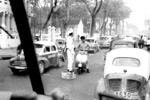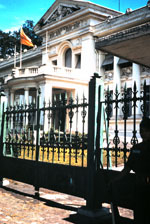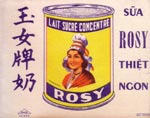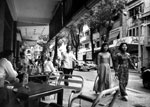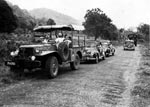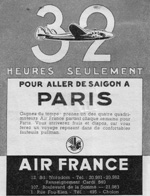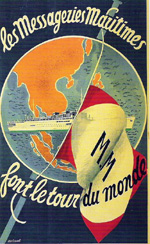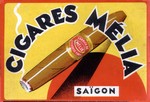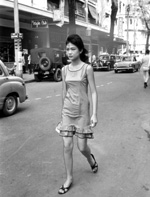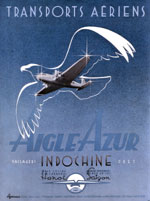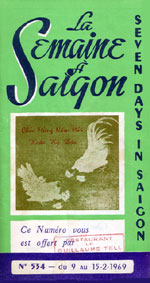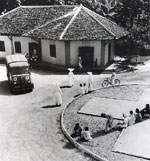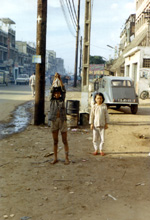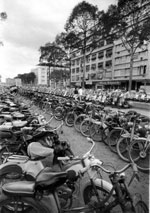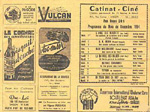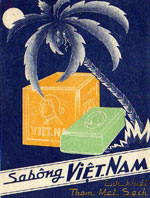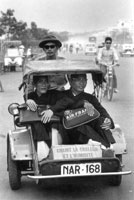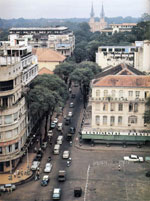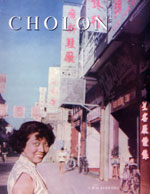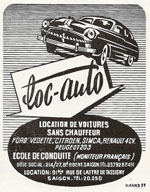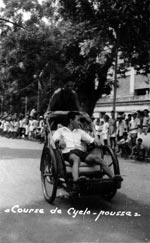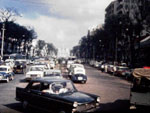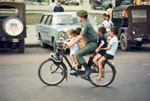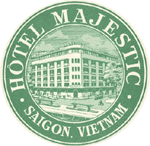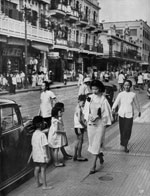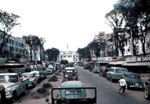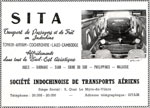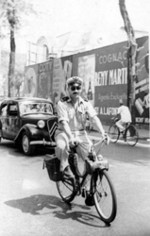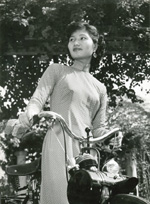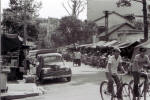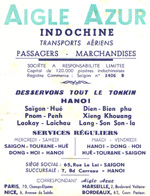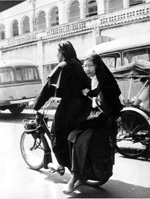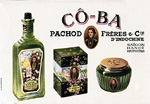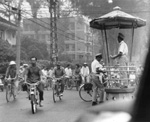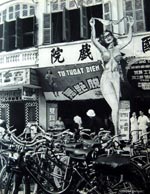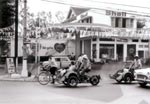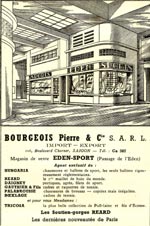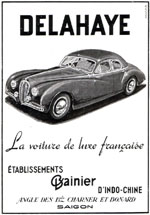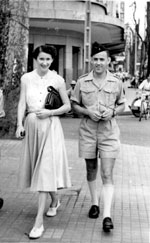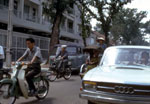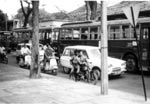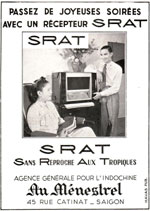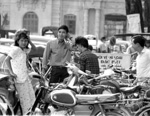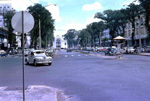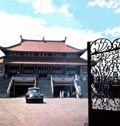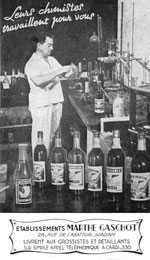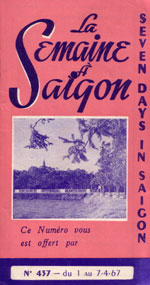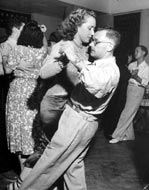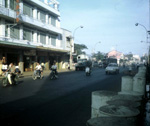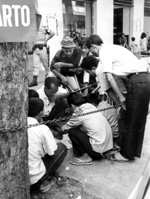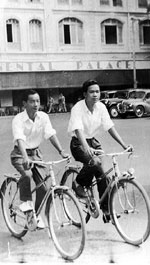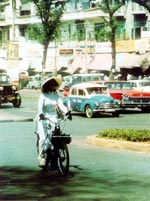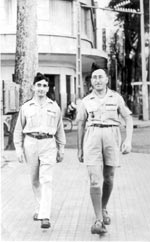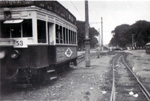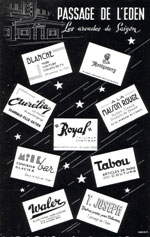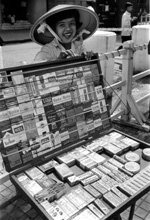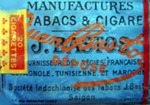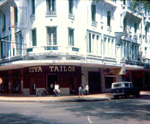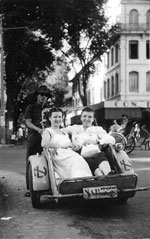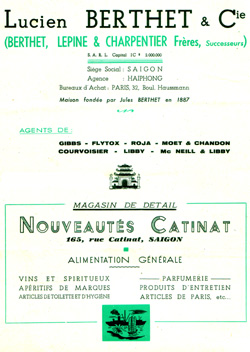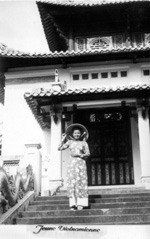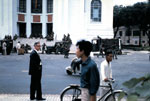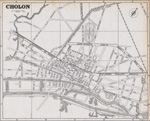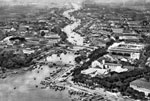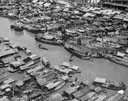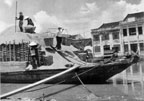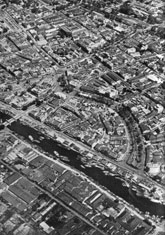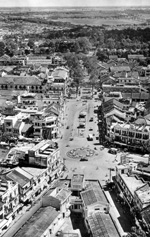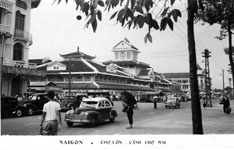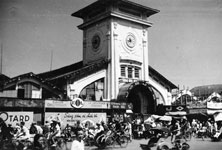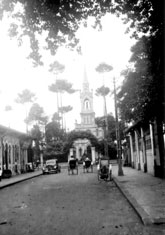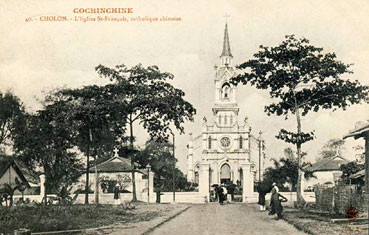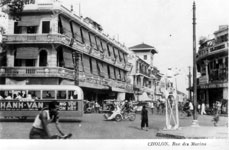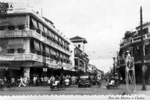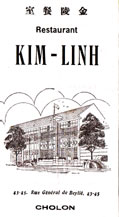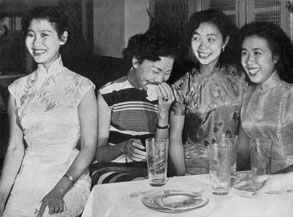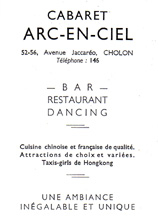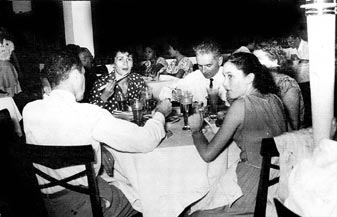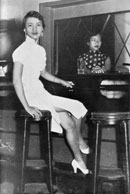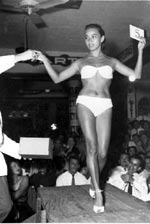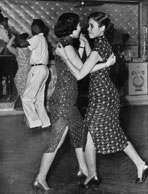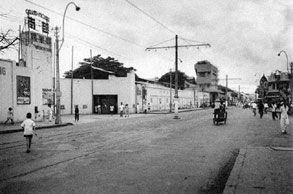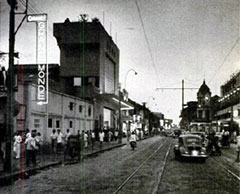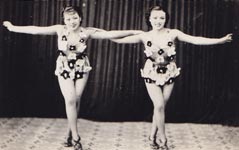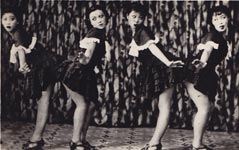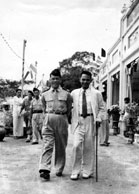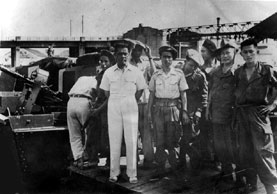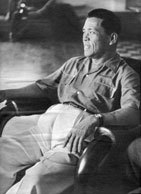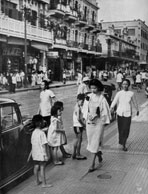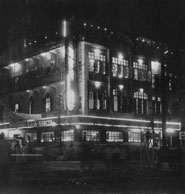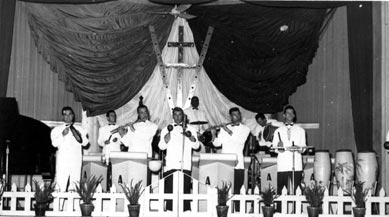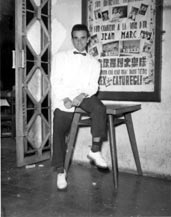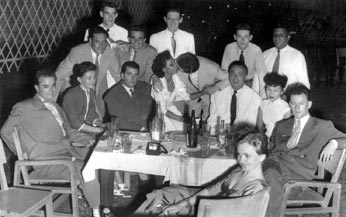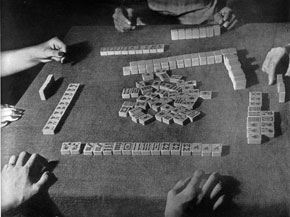
Cholon Chợ Lớn
(the chinese city)
Map of Cholon in 1953
The Chinese Arroyo ( Creek )
A fleet of 3000 Chinese sampans or junks were permanently moored, or traveled on the Chinese arroyo from the back country carrying raw or paddy rice to the factories of Cholon and then carrying the processed rice from these factories to the cargo ships anchored in the port of Saigon.
Several hundred thousand people lived in a âreed cityâ in a crowded tangle of sampans and barges. Entire families, from infants to the elderly are stacked in makeshift shelters aboard these craft. They have no civil standing, and spread out into Saigon and Cholon during the day.
Three organizations seek to take over this mass of people: the Viet Minh, the Bin-Xuyen, and the police, who wage a three-front war to control them.
Cholon Aerial view
In the photos (left and center): Bonard Canal.
In the photo on the left: Tang-Doc-Phuong Boulevard and Phu-To (Saigon race track).
Galliéni Boulevard
With a length of 5 kilometers, this boulevard is the main artery linking Saigon to Cholon. On it, one finds:
- The âParc Ă Bufflesâ (Buffalo Park), which at the end of the 1940âs and the beginning of the next decade is a gigantic whorehouse for the army with a scant sanitary cordon, numerous straw mats on a dirt floor and hundreds of girls controlled by âmother pimpsâ for the use of the French Expeditionary Corps.
- At the south end is Cholon, a Chinese city where Europeans donât live but where they go for exotics, refined pleasures, and the cuisine of the âPalais de Jadeâ (Jade Palace) and the âArc-en Cielâ (Rainbow), the two main dance halls.
Cholon's Central Market
(now Chợ Bến ThĂ nh)
HĂąu Giang (formely ThĂĄp MuĂČi)
Cholon means âbig marketâ and represents the large commercial center of the Cochin-Chinese capital, with a population of ethnic Chinese, the Hoa.
The Binh Tay market was built in 1928 and is recognizable by its belfry, it was designed by order of Quach DĂ m (1863 - 1927), and was managed by the municipality of Cholon.
It is still one of the busiest market places of the urban Saigon area. .
Firework's merchant in Cholon's central market
The Saint-Francis Church
The Saint-Francis (Saint-François) Church in Cholon (also called the Cham Tam Church, after Father Tam) is located at:
25 Trieu ChĂąu street (now Toc Lac)
The white and yellow church was built at the end of the 19th century.
Inside is the statue of Monsignor Francis-Xavier Tam Assou (1855-1934), originally an apostolic vicar of Chinese origin.
On November 2nd, 1963, President NgĂŽ Dinh DiĂȘm and his brother Ngo Dinh Nhu, fleeing a military coup, took refuge in the church, were arrested, and then executed on the road taking them to downtown Saigon.
Rue des Marins (Sailorâs Street)
Ăong KhĂĄnh in 1955 later Tran Hung Dao Avenue
At 11 Sailor's street is the âGrand Mondeâ
- " 48 "Huynh" Pastries
- " 182-184 "Restaurant "Diamant"
- " 325 "Novelties Bombay"
- " 386 "Franco-Chinese Bank "
- " 414 " Restaurant "Ai-Hue"
Cholon is the home of the Binh Tay and Kim Bien markets. The stalls stand side by side, and the mood is friendly between the comings and goings of wandering sellers and the alternating continued activity.
Hai Thuong Lan Ong Street bears the name of the great master of medicine of Vietnam. It is also known as the street of traditional medicine. The neighborhood is filled with hundreds of homeopathic and traditional Chinese pharmacies.
Restaurant Kim Linh
The restaurant Kim-Linh is located at 43-45 General de Beylié Street in Cholon, it was the rendezvous for the Europeans and French military personnel.
The Arc-en-Ciel
At the âArc-en-Cielâ is located at the corner of 52-56, Jaccareo avenue and Marins (sailor's) street.
The dĂ©cor is baroque, right down to the taxi-girls. The grand art of the taxi-girl is virtue, to be âinaccessibleâ. A ticket for a taxi-girl costs 100 piasters, which buys an hour of dancing and conversation.
The story of a taxi-girl at the âArc-en-Cielâ is magnificently told by Lucien Bodart as well as by Graham Greene.
The "Arc-en-Ciel" is also a fine restaurant...
The night clubs of Cholon
The Grand Monde
The Big World
At 11 Sailor's street is the âGrand Mondeâ (Big World), protected by large yellow walls.
At the end of 1948 it was the biggest gaming establishment in the world after Macao lost first place before the Second World War. Many games were available and with a majority of Chinese and Vietnamese players, the French were in the minority in this nebulous world. Tai-Xieu and Bac-Quan are absolutely unforgiving Chinese games.
The yearly lease is granted by the Vietnemese government, and the competition is stiff between the Macao Chinese and the Vietnamese from Bin-Xuen. It should be noted that the âGrand Mondeâ controls all: obviously the games, and also prostitution, the wholesale drug trade, the smuggling of gold, dollars, cigarettes, and counterfeiting, but Emperor Bao-DaĂŻ will intervene as a last resort.
Bay Vien, The Master of Cholon.
From left to right in the photographs:
Bay Vien Bay Vien and Colonel Leroy in 1949, Bay Vien afront the Y bridge in Cholon (Binh-Xuyen headquarters), Bay Vien (in 1955 GĂ©nĂ©ral LĂȘ Văn Viễn).
The Grand Monde is a « gaming farm », whose opening goes back to December 6th, 1946. It was âdecreedâ (into existence) by the French High-Commissioner Admiral Thierry dâArgenlieu despite protestations by the local government which was opposed to gambling.
The concessions were issued for a period of two years to the highest bidder. In December of 1948, this lease was bestowed by a consortium of Chinese capital from Macao which agreed to pay 400,000 piasters a day. Macao was at that time a Portuguese colony that existed almost exclusively from smuggling, gold, and gambling. The Macaists made a spectacular entrance into the Chinese city of Cholon, bringing with them their personnel: croupiers, singers, taxi-girls, accountants, and bodyguards!
Located in Cholon , on the « Rue des Marins », known for its boutiques and restaurants, the « Grand Monde » is a city within a city surrounded by a gigantic wall within which one finds a bit of everything : gaming halls, three theaters, two cinemas showing only westerns and Chinese cloak-and-dagger films, a pagoda, a boxing ring, acrobats, and noodle-sellers â a veritable Jacques PrĂ©vert-style inventory.
Everyone comes together at the « Grand Monde ». Old, miserable, toothless women rub shoulders with the most elegant courtesans with sparkling jewels.
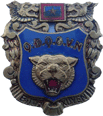


This man was Bay Vien, who, in 1951 was able to ally himself with the richest Chinese in Cholon as well as the Corsicans, the most notable of which was Franchini, the famous owner of the âHotel Continentalâ, and AndrĂ©ani, the owner of âThe Croix du Sudâ(Southern Cross) and the âMiradorâ, two luxurious night-clubs. Thanks to this objective partnership he became the master of Cholon, and the enormous income from the diverse and various activities of the âGrand Mondeâ would allow him to pay for the salaries and administration of his paramilitary troops, the âBinh-Xuyenâ.
After the fall of Dien Bien Phu in 1954, Ngo Dinh Diem, from the ""Norodon Palace" which had become the "Palace of Independance", closed the "Grand Monde" and outlawed gambling.
Bay Vien took the way of exile to France and died in Saint-Maur (Paris suburbs) in september 1972.
Cholon by day
Cholon by Night
The orchestra at the "Grand Monde"
A large wall separates the popular tables from the "Cabaret", with an exceptional dance floor of a hundred meters by thirty (330 by 100 ft.), featuring the French orchestra of Guy Paquinet (formerly of Ray Ventura's "Collégiens" orchestra which he left in March of 1947). The characteristic of this orchestra is that its members always played in a white tuxedo with a white carnation, and the tunes played often made reference to the post-war Parisian songs with taxi-girls, of course, superb girls dressed in silk.
After Guy Paquinet, it was Alex Caturegli who would conduct the "Grand Monde" orchestra, his brother Emile would join him in 1952.
The Alex Caturegli Orchestra
In the photo on the left: the Orchestra of the Grand Monde during a military gala in 1952
In the photo on the right: the poster for the show with the trumpet-player, Emile Caturegli.
A funny story told by Emile Caturegli :
On the dance floor we had our âmusician ratâ. He knew the beginning and end of each dance, and as soon as we started playing a piece he came out of his little hole in the floor and came over to eat a few peanuts, and as soon as the dance ended he went back to his hiding place. He was âourâ attraction!
On this photo the wedding of the pianist, Jean Hars; Jacques Chancel is also seen on the left with his wife.
Alex Caturegliâs orchestra also performed on Sundays at the Saigon Sporting Club (Cercle Sportif de SaĂŻgon), and recorded for the Jacques Chancel show, âRecreationâ, on Radio France-Asia as well.
After the âGrand Mondeâ, the Alex Caturegli Orchestra next appeared in Paris at the "Lido" as well as at the "Moulin Rouge".
The Mah Jong
(Mahjong, Majiang, Majong, Mahjongg
"Mah-Jong is, of course, the most popular game in Cholon.
When one moves about in Cholon in the evening, one hears the extraordinarily rapid and noisy hammering of the tiles being thrown on the tables, while the players are almost completely silent. Indeed, itâs a game that requires a very great tactical skill and great concentration, since the speed itself of the game can overcome a distracted opponent.
Additionally, one must follow the game which, with over one hundred forty tiles and three opponents, requires a certain effort. All in all, despite a large part left to chance, above all the best strategy is the one that wins."
Jean-Michel de Kermadec
The book on Cholon
The book "Cholon" was written by Jean-Michel de Kermadec with pictures from Raymond Cauchetier.
It was printed in december 1955 by "'Imprimerie Française d' Outre-Mer" (IFOM)
3, Rudyard-Kipling Street in Saigon.



